
Pictured
above starting in top row left to right: Paava Stults, Kirsten Mills,
2001
Senior Thesis Projects
Where available, abstracts for each project are printed
below.
Each year the Psychology seniors present their senior thesis
work at
Research Conference. Where available, links to the Powerpoint Presentations are provided.
BECK, KATHERINE
An Exploratory Study of Methods for Managing Behavior
Problems in Southern Indiana Schools.
Many school districts are addressing the issue of behavior problems in children (e.g., talking out, not paying attention, hitting others, talking back) which may cause a child to fall behind both academically and socially. The current study explores methods for managing children with behavior problems in Southern Indiana schools by interviewing nine school psychologists. School psychologists were chosen in order to maintain consistency between each school district. Each psychologist was asked a series of open-ended questions about how children with behavior problems in their school districts are identified and treated. The expected results were that not enough resources would be available in schools (staff, funds, etc.), few prevention programs would be in use, and that it would be more likely that a child with behavior problems would be removed from a general education classroom rather than using inclusion techniques. Results outline some of the more common responses as well as the exceptions 1) behavior problem evaluation process 2) behavior problem programs, 3) limitations of services, 4) prevention programs, and 5) perspectives on the role of a school psychologist. The implications of these issues for the future implementation of programs in schools are considered in the discussion. (Click here to see Katie’s PowerPoint presentation)
BAUDENDISTEL, STEVE
The
perception of power, wealth, and tipping styles.
The tipping style of people using a Casino valet service was examined over a four-week period. Tips given from 268 subjects were noted as well as the year and model of car, gender, group size, whether a tip was given or not, and perceived race of the individuals. The study hypothesized that a tip is given as an illustration of power over the valet and that the value of the driven car would be a strong predictor of the given tip. Therefor, an individual with a car of low stature would need to tip well in order to display power and an individual in a higher-priced car would not need to display anymore power since there car of choice has already done so. Also hypothesized was that, as noted in numerous other studies that males would tip better than females overall.
(Click here to see Steve's PowerPoint presentation)
Determinants of Attractiveness: Considering the
Relationship Between Attractiveness and the Ideal Body Size among Men and Women
Between and Within Various Cultures
Individuals
pursue an ideal body size for themselves and their mates. This ideal body size is determined by
individuals and may have profound physiological and psychological effects on an
individual. Explanations include both
cultural and socio-biological perspectives.
Culturally, this ideal size may have emerged from the influence of
popular culture and various indications of wealth. Socio-biologically, size preference may be motivated by sexual
maturity as means for survival. This
study seeks to determine factors pertaining to the ideal body size and its
effects on perceived attractiveness from both biological and cultural
perspectives. An Internet survey using
media exposure questions, ratings of the ideal body size, and the Body Shape
Questionnaire queried undergraduate students from various countries. The questionnaire was designed to attain the
socio-economic status of the participant and his or her exposure to popular
culture. The survey compared the
ratings of a woman’s ideal body size with the participant’s perceived size of
self. These questions were directed to
address the background and perceptions of the participant in order to correlate
his or her views with either cultural or socio-biological factors. Results partially support the cultural
perspective by showing correlations between the perceived ideal size and the
media exposure of the individual.
Because of the small amount of participants from diverse cultures, no
conclusion about the socio-biological perspective could be made. Future studies should research whether women
pursue a cultural ideal or what they think men are looking for as the ideal and
most attractive size of a woman.
(Click
here to see Lydia's PowerPoint presentation)
DOOROS, JAMIE & SCHEELE, JANETA
This study is an investigation of the perceptions of personal space invasion in relation to conditions of gender and density of social setting. The research was carried by means of a scenario study in which the subjects were asked to place themselves in the presented situation and rate the degree to which they perceived threat or attraction from a person invading their personal space. A 2 (gender) x 2 (density) mixed factorial design was run. The results indicated that males were more likely than females to perceive invasions of personal space as attraction, while females were more likely to perceive personal space invasions in terms of threat. Results also indicate that in non-crowded or empty situations, as opposed to crowded situations, the perceptions of threat and attraction were more intense. While there was no significant interaction found for the attraction variable, however there was an interaction for gender and density found in the perceived threat variable, indicating that females perceived significantly more threat during invasions of personal space than do males when in non-crowded social settings. Ideas to further the study of invasions of personal space are also provided, which include focus on same-sex personal space invasions as well as side-by-side versus face-to-face invasions, which were not explored in this study.
(Click
here to see Jamie & Janeta's PowerPoint presentation)
FRANCHVILLE,
CARRIE ANN
Young
Adults’ Perspectives on Their Parents’ Divorce
Research
concerning the impact of divorce on children has concentrated on short-term
effects more than long-term effects.
However, the impacts of divorce during childhood may linger into
adulthood, thus having a long-term effect, as young adults have previously
revealed when asked about the ways in which the divorce affected them. This study, inspired by Judith
Wallerstein’s research, will interview college students in order to address the
long-term impact of divorce and seek young adults’ perspectives of their
parents’ divorce. Approximately twenty
participants will each be given a short questionnaire before taking part in an
interview. The questionnaire is
comprised of questions concerning issues such as the conditions of custody
after the divorce, abuse before the divorce, and demographic information. An open-ended interview will further explore
perceived consequences of the divorce, and will address whether or not the
young adult agrees or disagrees with his/her parents’ decision to divorce. The commonalties and differences identified
between participants’ experiences will be articulated in respect to their
opinions of whether or not the divorce should have occurred. These findings will then be discussed in
respect to previous research on short-term and long-term effects.
(Click here to see Carrie's PowerPoint presentation)
JUNKINS, MONICA & EDWARDS, MANDI
Religious Affiliation and Attitudes Towards Women
A descriptive research study of males was conducted. All the participants completed surveys on dogmatism, attitudes towards women, religious beliefs, and religious motivations. The goal of this research was to examine if a relationship exists between a male’s level of religious commitment and the rigidity of his attitudes, specifically attitudes towards women. The two groups of males consisted of religiously affiliated men and men who were specifically affiliated with the Promise Keepers. The survey results are expected to display a significant correlation between the males in the Promise Keepers and conservative attitudes towards women as well as a closed belief system. This correlation could aid in identifying if religiosity, in general, is correlated with the conservative attitudes, or if these attitudes are contained with in the Promise Keepers. In theory, when social factors are combined with specific attitudes a behavior is produced. In any religious congregation, the males inherently hold specific views that create a belief system. The Promise Keepers have membership beyond basic denominations. They hold definite social and political dimensions that are unorthodox within general religious congregations. The social factors that are present within the Promise Keepers indicate that their attitudes will be unique as a population. If the correlation is significant for the Promise Keepers population, then future research could examine if the attitudes were present before the males joined the Promise Keepers, or if this religious group breeds those conservative attitudes.
KEM, DEBORAH
A Study of Adjustment to College in Relation to Birth
Order.
There is controversy regarding whether birth order itself has a role in the development of personality traits and behavior patterns that may impact adjustment. Studies have indicated that regardless of birth order, siblings in the same home experience different parental involvement and expectations that may then lead to the development of different behavior patterns. This proposes that parental treatment may mediate the relationship between birth order and adjustment, which may provide rationale for inconclusive results in previous studies on birth order and adjustment. This study examined the parental expectations and relationships experienced by undergraduate college students as an intervening variable between birth order and adjustment to college. The College Adjustment Scale and a scale measuring parental expectations and treatment were administered. It was found that parental expectations and treatment, rather than birth order, predicted adjustment to college in certain cases. The implications for adjustment to other environments and different parenting strategies are discussed.
(Click here to see Debi's PowerPoint presentation)
MAINS, BRANDY & STRICKLAND, ALICIA
Cultural Differences in the Treatment of Genders
in Classroom Interactions as Observed in
This is a cross-cultural study designed to determine how teachers interact with students of different genders and how these students interact in the classroom. These observations will be made in private and public high schools in Southeastern Indiana and in Merida, Mexico. Interactions and behaviors will be measured with the use of a checklist modified from a collection of surveys by Spielberger (1994). This study concentrates on socially accepted gender attitudes for both male and female students in Mexico and the U.S. Casas (1994) found that males were held to the social role of Machismo in the classroom while females were held to the social role of Marianismo. Based upon these accepted roles, males interacted more, were more disruptive, and were less discipline less than females in the classroom. Bem (1983) also reports similar data of classroom interactions in the U.S. Based upon this research, it is hypothesized that the data will indicate that males will receive responses that are more positive while females will receive more disapproving feedback from teachers. Even females are shown to interact less in the classroom they will receive more disciplinary actions in the classrooms than will males. It is also hypothesized that the data will indicate that these factors will be seen in the classrooms in Mexico, but to a greater extent.
(Click here to see Alicia & Brandy's PowerPoint presentation)
MILLS, KIRSTEN L.
A Study of the Factors Influencing Marriage Decisions Among College Seniors
Marriage has historically been considered a major part of the transition to adulthood. Because college graduation leaves young adults at a significant crossroads, with many decisions to make, this study examines the factors that influence marriage decisions among romantically involved college seniors. These factors include perceptions of social norms or deadlines for marriage, need for intimacy, quality of romantic relationship, future career plans, and marriage vs. career priorities. A survey was given to romantically involved college seniors at a small, private liberal arts college in the Midwest. Several significant results were found. It was found that those with higher needs for intimacy within romantic relationship reported greater readiness for marriage, as do those who perceive earlier deadlines for marriage. It was also found that those with greater levels of trust in relationship were more ready for marriage. It was found that women place greater priority on marriage than career. However, there were no significant results regarding priorities for men. In addition, the hypothesis that women would feel more ready for marriage was not supported. Finally, a regression analysis revealed that trust in relationship and perceived social deadlines are the strongest predictors for marriage. These results are helpful in understanding the decision-making process that college seniors must engage in, and helps to identify several factors that play into this decision, suggesting that social deadlines are the driving factors, with trust in relationships following closely.
(Click here to see Kirsten's PowerPoint presentation)
MOORE, MEGAN J.
Sexual Harassment of Professional Women: The Effect of Physical Appearance.
The present research explored the influence of females’
physical appearances on males’ willingness to sexually harass. Study 1 determined whether physical
appearance could serve as cues to computer-generated females’ sex role beliefs. Male and female undergraduates responded as
they believed women pictured would respond on a sexism scale. Study 2 measured male participants’ reported
degree of sexism, affective reactions towards, and likelihood to sexually
harass egalitarian or traditional pictorial women. An egalitarian woman was more likely to be sexually harassed and
high sexists were more likely to sexually harass. Results imply that women who dress in egalitarian manners in the
workplace, such as professional women, are more susceptible to sexual
harassment than traditional women. Note:
Megan also presented her work at the 2002 Society for Personality and Social
Psychologists Meeting. Click here for
details.
(Click here to see Megan's PowerPoint presentation)
REMBADO, ALICE
Reactions to Emotional and Physical Infidelity.
Past studies on men’s and women’s reactions to emotional and physical infidelity within a romantic relationship have indicated that men are more upset over physical infidelity than emotional infidelity and women more upset over emotional infidelity than physical infidelity. Evolutionary theorists have attempted to explain these findings by the parental investment model. Other researchers, however, have suggested that these gender differences might be explained by sociocultural and individual factors rather than by evolutionary factors. The current study examined the degree to which other factors, including gender roles, the extent to which people think sex and love go together, and how liberal people’s attitudes are regarding their sexuality, might account for gender differences in reactions to physical and emotional infidelity. Differences in reactions to infidelity were found, and did not support the evolutionary theory. Women and men were found to be more upset over physical than emotional infidelity, women overall were found to be more upset over both types of infidelity than men, and women were found to be more jealous than men.
STARR, ADAM
The
Relationship Between Public Perceptions of Mental Illness and Contact with
Mentally Ill Individuals.
The relationship between public perceptions of "mental illness" and contact with mentally ill people has been researched. This research suggests that increased contact with people that are mentally ill is related to a decrease in negative attitudes toward them. However, the specific relationship between the public's perception of individual disorders and contact with these disorders has not been given as much attention. The present study surveyed 90 adults (33 males and 57 females, age M = 51) in two small southeastern Indiana towns via a telephone survey. The survey used Likert scales to assess participants’ perceptions of five different mental disorders (schizophrenia, depression, alcohol abuse, paranoia, and eating disorders) along four different behavioral characteristics (uncontrollable, violent, unpredictable, and dangerous). All five disorders were perceived significantly different from each other. In addition, there was a pattern for perception from least to most negative (eating disorders, depression, paranoia, & alcohol abuse and schizophrenia), with exception to alcohol abuse and schizophrenia being perceived as the most negative. However, the evidence from this study for a relationship between perceptions and amount of contact was lacking. Several implications emerged from the study regarding issues of the “contact hypothesis,” and improving the relationship between mentally ill people and the public.
(Click here to see Adam's PowerPoint presentation)
STULTS, M. PAAVA
Motivation and Perceived Relatedness: Relationships of
Gender, Intercollegiate Sport Division, and Other Factors
This study investigated the relationships between motivation
and perceived relatedness (PR) and the differences in motivation and PR for the
different genders and intercollegiate sport divisions. Athletes (N = 243) from 10 schools in
NCAA Division I, II, and III and NAIA II (in California and Indiana) completed
the Sport Motivation Scale and the Perceived Relatedness Scale. Results indicate that PR intimacy can predict
the unique variance for intrinsic motivation (IM) stimulation and extrinsic
motivation (EM) identification. PR
acceptance can predict the unique variance for IM knowledge, IM accomplishment,
and amotivation. Main results and
interactions were also reported for gender, intercollegiate sport division, and
sport type. Results are discussed in
terms of self-determination theory and organismic integration theory. NOTE: Paava also presented his project at the May 2001 meeting of the
Midwestern Psychological Association. Click here for details.
(Click
here to see Paava's PowerPoint presentation)
WILSON, DANIELLE
A Cultural Comparison: Attitudes Towards Mental Illness in India and the United States
Previous research has indicated that public perceptions of the mentally ill can be influenced by socio-cultural factors. The degree of individualism/collectivism is one cultural factor that has been found to vary between cultures. Research has shown that India and the United States differ both in extent of individualism and in public attitude toward mental illness. Since extent of individualism is one of the major cultural differences between Indian and American cultures, this study investigates a possible relationship between extent of individualism in a society and public beliefs about the mentally ill. Surveys were administered to 50 volunteers in a public library setting in cities in the U.S. and India. Extent of individualism was measured by the social isolation factor of Hui and Yee’s shortened Individualism-Collectivism (INDCOL) scale. Hirai & Clum’s Beliefs toward Mental Illness scale (BMI) was used to measure beliefs toward mental illness. It was expected that subjects from India would have both a more positive attitude towards mental illness and also demonstrate less individualism than subjects from U.S., however, this was not supported by the data from this study. It was also expected that for both countries there would be a correlation between level of individualism and negative attitudes towards mental illness, and this was significantly supported by the data (r = -0.28, p < 0.01, N = 95). However, this significant finding was driven completely by the Indian participants (r = -0.57, p = 0.00, n = 40), because there was no significant relationship between social isolation and attitudes toward mental illness in U.S. participants. Implications of these findings in regards to a society’s emphasis on either individualism or collectivism and the ramification of this in establishing cultural stigma attached to the mentally ill are discussed.



